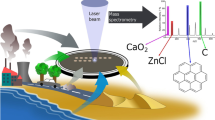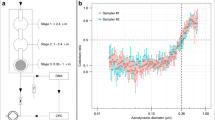Abstract
Secondary organic aerosol (SOA) accounts for a significant fraction of particulate matter (PM) in the atmosphere. Source identification, including the SOA fraction, is critical for the effective management of air pollution. Molecular SOA markers (tracers) are key compounds allowing the source apportionment of SOA using different methodologies. Therefore, accurate SOA marker measurements in ambient air PM are important. This study determined the concentrations of 12 key SOA markers (biogenic and anthropogenic) in the urban dust standard reference material available from the National Institute of Standards and Technology (NIST) (SRM 1649b). Two extraction procedures, sonication and QuEChERS-like (quick easy cheap effective rugged and safe), have been compared. Three research laboratories/institutes using two analytical techniques (gas chromatography/mass spectrometry (GC/MS) and ultra-high-pressure liquid chromatography/tandem mass spectrometry (HPLC/MS-MS)) carried out the analyses. The results obtained were all in good agreement, except for 2-methylerythritol. The analysis of this compound still seems to be challenging by both GC/MS (large injection repeatability) and HPLC/MS-MS (separation issues of both 2-methyltetrols: 2-methylthreitol and 2-methylerythritol). Possible inhomogeneity in the SRM for this compound could also explain the large discrepancies observed. Sonication and QuEChERS-like procedures gave comparable results for the extraction of the SOA markers showing that QuEChERS-like extraction is suitable for the analysis of SOA markers in ambient air PM. As this study provides, for the first time, indicative values in a reference material for typical SOA markers, the analysis of SRM 1649b (urban dust) could be used for quality control/assurance purposes.

Graphical abstract

Similar content being viewed by others
References
Zhang Q, Jimenez JL, Canagaratna MR, Allan JD, Coe H, Ulbrich I, et al. Ubiquity and dominance of oxygenated species in organic aerosols in anthropogenically-influenced Northern Hemisphere midlatitudes. Geophys Res Lett. 2007;34(13):L13801.
Ziemann PJ, Atkinson R. Kinetics, products, and mechanisms of secondary organic aerosol formation. Chem Soc Rev. 2013;41(19):6582–605.
Carlton AG, Wiedinmyer C, Kroll JH. A review of Secondary Organic Aerosol (SOA) formation from isoprene. Atmos Chem Phys. 2009;9(14):4987–5005.
Hallquist M, Wenger JC, Baltensperger U, Rudich Y, Simpson D, Claeys M, et al. The formation, properties and impact of secondary organic aerosol: current and emerging issues. Atmos Chem Phys. 2009;9(14):5155–236.
Kroll JH, Seinfeld JH. Chemistry of secondary organic aerosol: formation and evolution of low-volatility organics in the atmosphere. Atmos Environ. 2008;42(16):3593–624.
Zhang Q, Jimenez JL, Canagaratna MR, Ulbrich IM, Ng NL, Worsnop DR, et al. Understanding atmospheric organic aerosols via factor analysis of aerosol mass spectrometry: a review. Anal Bioanal Chem. 2011;401(10):3045–67.
Srivastava D, Favez O, Perraudin E, Villenave E, Albinet A. Comparison of measurement-based methodologies to apportion secondary organic carbon (SOC) in PM2.5: a review of recent studies. Atmosphere. 2018;9(11):452.
Nozière B, Kalberer M, Claeys M, Allan J, D’Anna B, Decesari S, et al. The molecular identification of organic compounds in the atmosphere: state of the art and challenges. Chem Rev. 2015;115(10):3919–83.
Kleindienst TE, Jaoui M, Lewandowski M, Offenberg JH, Lewis CW, Bhave PV, et al. Estimates of the contributions of biogenic and anthropogenic hydrocarbons to secondary organic aerosol at a southeastern US location. Atmos Environ. 2007;41(37):8288–300.
Srivastava D, Favez O, Bonnaire N, Lucarelli F, Haeffelin M, Perraudin E, et al. Speciation of organic fractions does matter for aerosol source apportionment. Part 2: intensive short-term campaign in the Paris area (France). Sci Total Environ. 2018;634:267–78.
Srivastava D, Tomaz S, Favez O, Lanzafame GM, Golly B, Besombes J-L, et al. Speciation of organic fraction does matter for source apportionment. Part 1: a one-year campaign in Grenoble (France). Sci Total Environ. 2018;624:1598–611.
Al-Naiema IM, Hettiyadura APS, Wallace HW, Sanchez NP, Madler CJ, Cevik BK, et al. Source apportionment of fine particulate matter in Houston, Texas: insights to secondary organic aerosols. Atmos Chem Phys. 2018;18(21):15601–22.
Srivastava D, Favez O, Petit J-E, Zhang Y, Sofowote UM, Hopke PK, et al. Speciation of organic fractions does matter for aerosol source apportionment. Part 3: combining off-line and on-line measurements. Sci Total Environ. 2019. https://doi.org/10.1016/j.scitotenv.2019.06.378.
Edney EO, Kleindienst TE, Jaoui M, Lewandowski M, Offenberg JH, Wang W, et al. Formation of 2-methyl tetrols and 2-methylglyceric acid in secondary organic aerosol from laboratory irradiated isoprene/NOX/SO2/air mixtures and their detection in ambient PM2.5 samples collected in the eastern United States. Atmos Environ. 2005;39(29):5281–9.
Claeys M, Graham B, Vas G, Wang W, Vermeylen R, Pashynska V, et al. Formation of secondary organic aerosols through photooxidation of isoprene. Science. 2004;303(5661):1173.
Szmigielski R, Surratt JD, Gómez-González Y, Van der Veken P, Kourtchev I. Vermeylen R, et al. 3-methyl-1,2,3-butanetricarboxylic acid: an atmospheric tracer for terpene secondary organic aerosol. Geophys Res Lett. 2007;34(24):L24811.
Mutzel A, Rodigast M, Iinuma Y, Böge O, Herrmann H. Monoterpene SOA – contribution of first-generation oxidation products to formation and chemical composition. Atmos Environ. 2016;130:136–44.
Claeys M, Szmigielski R, Kourtchev I, Van der Veken P, Vermeylen R, Maenhaut W, et al. Hydroxydicarboxylic acids: markers for secondary organic aerosol from the photooxidation of α-pinene. Environ Sci Technol. 2007;41(5):1628–34.
Yu J, Cocker DR, Griffin RJ, Flagan RC, Seinfeld JH. Gas-phase ozone oxidation of monoterpenes: gaseous and particulate products. J Atmos Chem. 1999;34(2):207–58.
Glasius M, Lahaniati M, Calogirou A, Di Bella D, Jensen NR, Hjorth J, et al. Carboxylic acids in secondary aerosols from oxidation of cyclic monoterpenes by ozone. Environ Sci Technol. 2000;34(6):1001–10.
Jang M, Kamens RM. Newly characterized products and composition of secondary aerosols from the reaction of α-pinene with ozone. Atmos Environ. 1999;33(3):459–74.
Christoffersen TS, Hjorth J, Horie O, Jensen NR, Kotzias D, Molander LL, et al. cis-Pinic acid, a possible precursor for organic aerosol formation from ozonolysis of α-pinene. Atmos Environ. 1998;32(10):1657–61.
Jaoui M, Lewandowski M, Kleindienst TE, Offenberg JH, Edney EO. β-Caryophyllinic acid: an atmospheric tracer for β-caryophyllene secondary organic aerosol. Geophys Res Lett. 2007;34(5):L05816.
Kawamura K, Bikkina S. A review of dicarboxylic acids and related compounds in atmospheric aerosols: molecular distributions, sources and transformation. Atmos Res. 2016;170:140–60.
Kleindienst TE, Jaoui M, Lewandowski M, Offenberg JH, Docherty KS. The formation of SOA and chemical tracer compounds from the photooxidation of naphthalene and its methyl analogs in the presence and absence of nitrogen oxides. Atmos Chem Phys. 2012;12(18):8711–26.
Kleindienst TE, Conver TS, McIver CD, Edney EO. Determination of secondary organic aerosol products from the photooxidation of toluene and their implications in ambient PM2.5. J Atmos Chem. 2004;47(1):79–100.
Iinuma Y, Böge O, Gräfe R, Herrmann H. Methyl-nitrocatechols: atmospheric tracer compounds for biomass burning secondary organic aerosols. Environ Sci Technol. 2010;44(22):8453–9.
Wise S, Poster D, Kucklick J, Keller J, VanderPol S, Sander L, et al. Standard reference materials (SRMs) for determination of organic contaminants in environmental samples. Anal Bioanal Chem. 2006;386(4):1153–90.
NIST. Standard reference material 1649b, urban dust. Gaithersburg: National Institute of Standards and Technology; 2015.
Albinet A, Leoz-Garziandia E, Budzinski H, Villenave E. Simultaneous analysis of oxygenated and nitrated polycyclic aromatic hydrocarbons on standard reference material 1649a (urban dust) and on natural ambient air samples by gas chromatography-mass spectrometry with negative ion chemical ionisation. J Chromatogr A. 2006;1121(1):106–13.
Albinet A, Nalin F, Tomaz S, Beaumont J, Lestremau F. A simple QuEChERS-like extraction approach for molecular chemical characterization of organic aerosols: application to nitrated and oxygenated PAH derivatives (NPAH and OPAH) quantified by GC–NICIMS. Anal Bioanal Chem. 2014;406(13):3131–48.
Larsen RK, Schantz MM, Wise SA. Determination of Levoglucosan in particulate matter reference materials. Aerosol Sci Technol. 2006;40(10):781–7.
Kitanovski Z, Grgić I, Vermeylen R, Claeys M, Maenhaut W. Liquid chromatography tandem mass spectrometry method for characterization of monoaromatic nitro-compounds in atmospheric particulate matter. J Chromatogr A. 2012;1268:35–43.
Kitanovski Z, Grgić I, Yasmeen F, Claeys M, Čusak A. Development of a liquid chromatographic method based on ultraviolet–visible and electrospray ionization mass spectrometric detection for the identification of nitrocatechols and related tracers in biomass burning atmospheric organic aerosol. Rapid Commun Mass Spectrom. 2012;26(7):793–804.
Clements AL, Seinfeld JH. Detection and quantification of 2-methyltetrols in ambient aerosol in the southeastern United States. Atmos Environ. 2007;41(9):1825–30.
Fu P, Aggarwal SG, Chen J, Li J, Sun Y, Wang Z, et al. Molecular markers of secondary organic aerosol in Mumbai, India. Environ Sci Technol. 2016;50(9):4659–67.
Hu D, Bian Q, Li TWY, Lau AKH, Yu JZ. Contributions of isoprene, monoterpenes, β-caryophyllene, and toluene to secondary organic aerosols in Hong Kong during the summer of 2006. J Geophys Res Atmos. 2008;113(D22):D22206.
Rutter AP, Snyder DC, Stone EA, Shelton B, DeMinter J, Schauer JJ. Preliminary assessment of the anthropogenic and biogenic contributions to secondary organic aerosols at two industrial cities in the upper Midwest. Atmos Environ. 2014;84:307–13.
Kourtchev I, Ruuskanen TM, Keronen P, Sogacheva L, Dal Maso M, Reissell A, et al. Determination of isoprene and α-/β-pinene oxidation products in boreal forest aerosols from Hyytiälä, Finland: diel variations and possible link with particle formation events. Plant Biol. 2008;10(1):138–49.
Gao S, Surratt JD, Knipping EM, Edgerton ES, Shahgholi M, Seinfeld JH. Characterization of polar organic components in fine aerosols in the southeastern United States: identity, origin, and evolution. J Geophys Res Atmos. 2006;111:D14.
Albinet A, Tomaz S, Lestremau F. A really quick easy cheap effective rugged and safe (QuEChERS) extraction procedure for the analysis of particle-bound PAHs in ambient air and emission samples. Sci Total Environ. 2013;450-451(0):31–8.
Tomaz S, Jaffrezo J-L, Favez O, Perraudin E, Villenave E, Albinet A. Sources and atmospheric chemistry of oxy- and nitro-PAHs in the ambient air of Grenoble (France). Atmos Environ. 2017;161:144–54.
Tomaz S, Shahpoury P, Jaffrezo J-L, Lammel G, Perraudin E, Villenave E, et al. One-year study of polycyclic aromatic compounds at an urban site in Grenoble (France): seasonal variations, gas/particle partitioning and cancer risk estimation. Sci Total Environ. 2016;565:1071–83.
Mutzel A, Rodigast M, Iinuma Y, Böge O, Herrmann H. An improved method for the quantification of SOA bound peroxides. Atmos Environ. 2013;67:365–9.
Kleindienst TE, Lewandowski M, Offenberg JH, Edney EO, Jaoui M, Zheng M, et al. Contribution of primary and secondary sources to organic aerosol and PM2.5 at SEARCH network sites. J Air Waste Manage Assoc. 2010;60(11):1388–99.
Kourtchev I, Ruuskanen T, Maenhaut W, Kulmala M, Claeys M. Observation of 2-methyltetrols and related photo-oxidation products of isoprene in boreal forest aerosols from Hyytiälä, Finland. Atmos Chem Phys. 2005;5(10):2761–70.
Alier M, van Drooge BL, Dall'Osto M, Querol X, Grimalt JO, Tauler R. Source apportionment of submicron organic aerosol at an urban background and a road site in Barcelona (Spain) during SAPUSS. Atmos Chem Phys. 2013;13(20):10353–71.
Yuan Q, Lai S, Song J, Ding X, Zheng L, Wang X, et al. Seasonal cycles of secondary organic aerosol tracers in rural Guangzhou, Southern China: the importance of atmospheric oxidants. Environ Pollut. 2018;240:884–93.
Ion AC, Vermeylen R, Kourtchev I, Cafmeyer J, Chi X, Gelencsér A, et al. Polar organic compounds in rural PM2.5 aerosols from K-puszta, Hungary, during a 2003 summer field campaign: sources and diel variations. Atmos Chem Phys. 2005;5(7):1805–14.
Acknowledgements
The authors wish to thank the French Ministry of Environment for their financial support. They also thank Siham Ayachi, Xavier Pollion (LSCE), and Jérôme Beaumont (INERIS), for their technical assistance and the chemical analyses performed.
Author information
Authors and Affiliations
Corresponding author
Ethics declarations
Conflict of interest
S. Wise and F. Nalin worked at the NIST which also provides the standard reference materials (SRM). The other authors declare that they have no conflict of interest.
Additional information
Publisher’s note
Springer Nature remains neutral with regard to jurisdictional claims in published maps and institutional affiliations.
Electronic supplementary material
ESM 1
(PDF 178 kb)
Rights and permissions
About this article
Cite this article
Albinet, A., Lanzafame, G.M., Srivastava, D. et al. Analysis and determination of secondary organic aerosol (SOA) tracers (markers) in particulate matter standard reference material (SRM 1649b, urban dust). Anal Bioanal Chem 411, 5975–5983 (2019). https://doi.org/10.1007/s00216-019-02015-6
Received:
Revised:
Accepted:
Published:
Issue Date:
DOI: https://doi.org/10.1007/s00216-019-02015-6




